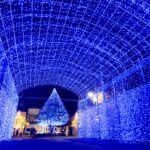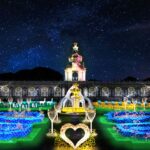Saga
Where is Saga?
Saga Prefecture is located on the island of Kyushu in southwestern Japan, bordering Fukuoka, Nagasaki, and Kumamoto Prefectures. Facing the Sea of Japan to the north and the Ariake Sea to the west, Saga enjoys a mild climate. Its capital city is also named Saga. The prefecture is known for its rich agricultural output, particularly rice, which contributes to its nickname, the “Granary of Kyushu.” Key agricultural products also include strawberries, mandarin oranges, and nori seaweed. Historically, Saga played a significant role in Japan’s modernization, with a strong tradition in pottery, including the renowned Arita and Imari porcelain. Traveling to Saga is accessible by train via the JR Nagasaki Shinkansen or other JR lines. Fukuoka Airport serves as the closest major airport, with convenient connecting transport to Saga. While smaller than some of its neighboring prefectures, Saga offers a tranquil escape with historical sites, natural onsen (hot springs), and opportunities to experience traditional Japanese culture.
What is Saga known for?
Saga Prefecture, located on Kyushu island in Japan, faces the Sea of Japan and the East China Sea. Historically, it was divided into Saga and Nagasaki, emerging as a key point for international trade during the Edo period (1603-1867) due to its proximity to Korea and China. Arita, a town within Saga, became renowned for porcelain production starting in the 17th century, heavily influencing European styles. After the Meiji Restoration (1868), Saga was integral to Japans modernization, particularly in coal mining and the development of naval technology. During World War II, the prefecture played a role in Japans war effort. Today, Saga is known for its rich history of porcelain, including the Arita ware and Imari ware styles. It also produces high-quality green tea, rice, and sake. Visitors can explore historical sites like Yoshinogari Historical Park, a large Yayoi period settlement, and Saga Castle History Museum. The Saga International Balloon Fiesta, held annually, is another major attraction.
Where should I visit in Saga?
Saga Prefecture offers a diverse range of activities for travelers. Here’s a look at some key attractions and experiences: **Historical and Cultural Sites:** * **Yoshinogari Historical Park:** This large park contains the remains of a Yayoi period settlement (300 BC – 300 AD), showcasing reconstructed buildings, burial mounds, and artifacts providing insight into daily life during that era. * **Saga Castle History Museum:** Located within the reconstructed Saga Castle, the museum exhibits artifacts relating to the Nabeshima clan, who ruled the region for centuries. You can also explore the castle grounds and admire the reconstructed main keep. * **Karatsu Castle:** A hilltop castle offering panoramic views of Karatsu city and the Karatsu Bay. The castle features exhibits related to its history and the local area. * **Arita Porcelain Park:** Celebrate Arita’s history as the birthplace of porcelain in Japan. The park includes a museum, workshops, and shops showcasing the artistry and craftsmanship of Arita ware. **Nature and Outdoor Activities:** * **Niji-no-Matsubara (Rainbow Pine Grove):** A scenic coastal pine grove stretching for approximately 5 kilometers along Karatsu Bay. Enjoy walking, cycling, or simply relaxing by the sea. * **Yutoku Inari Shrine:** One of the three great Inari shrines in Japan. Known for its numerous red torii gates winding up the mountainside. * **Seven Colored Sea of Nanaura:** The tidal flats of Nanaura create a unique landscape with varying hues depending on the tides and sunlight. Boat tours are available for closer observation. * **Mount Sefuri:** A popular hiking destination with various trails catering to different skill levels. Enjoy views of the surrounding landscape from the summit. **Other Activities:** * **Takeo Onsen:** A historic hot spring town known for its unique public bathhouses and traditional atmosphere. Consider staying overnight in a *ryokan* (traditional Japanese inn). * **Try Saga Beef:** Saga beef is a highly prized wagyu beef known for its marbling and flavor. Sample it at local restaurants. * **Arita Ware Shopping:** Purchase authentic Arita porcelain directly from workshops and shops in Arita town. **Transportation within Saga:** Saga is relatively easy to navigate using trains and buses. A rental car can be useful for exploring more remote areas. Consider purchasing a regional rail pass if you plan on extensive train travel. It is recommended to check opening hours, admission fees, and transportation options before your trip, as these may vary.
When is the best time to visit Saga?
The best time to visit Saga Prefecture depends on your interests. For pleasant weather and outdoor activities, spring (March-May) and autumn (September-November) are ideal. Spring offers comfortable temperatures and the chance to see Saga’s famous cherry blossoms, particularly around Mifuneyama Rakuen Park. Autumn brings beautiful fall foliage, especially in the northern mountainous areas. Summer (June-August) is hot and humid, suitable for beachgoers heading to the Karatsu coast, but can be uncomfortable for extensive sightseeing. Winter (December-February) is relatively mild with occasional snowfall, making it a good time to experience onsen (hot springs) and local winter festivals like the Tamatori Eyo fire festival in Takeo Onsen. If you’re interested in specific events, research festival dates beforehand, as they can greatly influence the best time for your visit. Keep in mind, typhoon season typically runs from July to October, which could impact travel plans.
All Events in Saga
Saga Light Fantasy
Saga Illuminage
Tours and Activities in Saga
None found.
Where should I stay in Saga?
The best place to stay in Saga Prefecture depends on your interests and budget. For those seeking hot springs and natural beauty, Ureshino Onsen is a top choice, offering a range of accommodations from budget-friendly to luxurious. History buffs might prefer Saga City, with its proximity to historical sites like the Saga Castle History Museum. Nature lovers could opt for the coastal town of Karatsu, known for its beautiful beaches and scenic islands. Budget travellers can find comfortable and affordable rooms at the Ureshino Onsen Kasuga Hotel, which offers simple but clean accommodations and access to the town’s famous hot springs. For a luxurious experience, consider staying at the Yoyokaku in Ureshino Onsen. This high-end ryokan boasts exquisite traditional Japanese rooms, private onsen baths, and exceptional cuisine, offering a truly pampered experience. Ultimately, whether you prefer a bustling city, a relaxing onsen town, or a coastal escape, Saga Prefecture has a perfect place to stay for every traveler.
How do I get to Saga?
Saga Prefecture, located on the island of Kyushu in Japan, is accessible by various means. The nearest major airport is Fukuoka Airport (FUK), which offers domestic and international flights. From Fukuoka Airport, you can take a direct JR limited express train to Saga Station, the prefecture’s central transportation hub, in approximately 40 minutes. Alternatively, the Hakata Bus Terminal in Fukuoka City provides highway bus services to Saga City and other locations within the prefecture. If traveling from other parts of Kyushu, the JR Nagasaki Main Line and Sasebo Line connect Saga with major cities like Nagasaki, Sasebo, and Kumamoto. For those arriving by car, the Kyushu Expressway provides access to Saga Prefecture. The Nishi-Kyushu Expressway also runs through the prefecture, connecting it to other destinations within Kyushu. Ferries operate from various ports, including Nagasaki, to the islands off the coast of Saga. Within Saga Prefecture, local bus networks and train lines connect smaller towns and villages. Renting a car is also a viable option for exploring the prefecture at your own pace.


